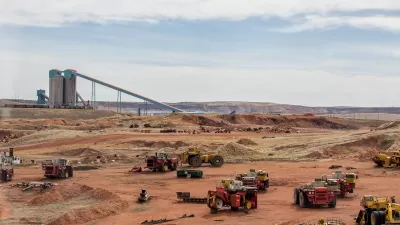The battleground is the Big Sandy coal power plant in eastern Kentucky. The owner, American Electric Power, under pressure from coal proponents, agreed to do a $1 billion retrofit rather than switching to natural gas. Victory was short-lived.
Writing for the 'energy rush' series, Eric Lipton details the 'perfect storm' that has hit the coal industry. First there were the environmental regulations that originated with the 1990, Bush Clean Air Act amendments. Then the environmental community, aided by $50 million from NYC Mayor Michael Bloomberg and $26 million from Aubrey K. McClendon, the (embattled) chief executive of Chesapeake Energy, targeted coal plants in major campaigns. Finally, "a surge in production of natural gas through the process of hydraulic fracturing, known as fracking, has sent gas prices plummeting."
"The math screams at you to do gas," said Michael G. Morris, the chairman of the plant's operator, American Electric Power, whose company is the nation's largest consumer of coal." Nonetheless, the decision made last summer to switch to natural gas was reversed, much to the relief of legislators, the coal companies, land owners, railroad companies, and union leaders.
The $1 billion retrofit to meet clean air regulations would have been financed by a rate increase if the state utility commission had agreed.
Lipton provides perspectives from all sectors - those who make their living from coal, those trying to shut the plant down, and consumers of the electric power reluctant to pay the rate surcharge to finance the retrofit.
Lipton updates the May 29 article in his Green blog the next day:
"American Electric Power conceded defeat on Wednesday (May 30), at least temporarily, in its push to save Big Sandy, its 49-year-old coal-burning plant in eastern Kentucky, surprising state officials there by withdrawing its $1 billion plan to retrofit the power plant so that it can meet tough new federal environmental regulations.
AEP, as the Ohio-based company is known, did not formally declare that it was retiring Big Sandy. But it will now need to at least temporarily shut it down because it will not have enough time to install the required pollution controls..."
The blog does not indicate whether the plant will be converted to burn natural gas.
FULL STORY: THE ENERGY RUSH: Even in Coal Country, the Fight for an Industry

Alabama: Trump Terminates Settlements for Black Communities Harmed By Raw Sewage
Trump deemed the landmark civil rights agreement “illegal DEI and environmental justice policy.”

Study: Maui’s Plan to Convert Vacation Rentals to Long-Term Housing Could Cause Nearly $1 Billion Economic Loss
The plan would reduce visitor accommodation by 25% resulting in 1,900 jobs lost.

Planetizen Federal Action Tracker
A weekly monitor of how Trump’s orders and actions are impacting planners and planning in America.

Wind Energy on the Rise Despite Federal Policy Reversal
The Trump administration is revoking federal support for renewable energy, but demand for new projects continues unabated.

Passengers Flock to Caltrain After Electrification
The new electric trains are running faster and more reliably, leading to strong ridership growth on the Bay Area rail system.

Texas Churches Rally Behind ‘Yes in God’s Back Yard’ Legislation
Religious leaders want the state to reduce zoning regulations to streamline leasing church-owned land to housing developers.
Urban Design for Planners 1: Software Tools
This six-course series explores essential urban design concepts using open source software and equips planners with the tools they need to participate fully in the urban design process.
Planning for Universal Design
Learn the tools for implementing Universal Design in planning regulations.
Caltrans
Smith Gee Studio
Institute for Housing and Urban Development Studies (IHS)
City of Grandview
Harvard GSD Executive Education
Toledo-Lucas County Plan Commissions
Salt Lake City
NYU Wagner Graduate School of Public Service





























